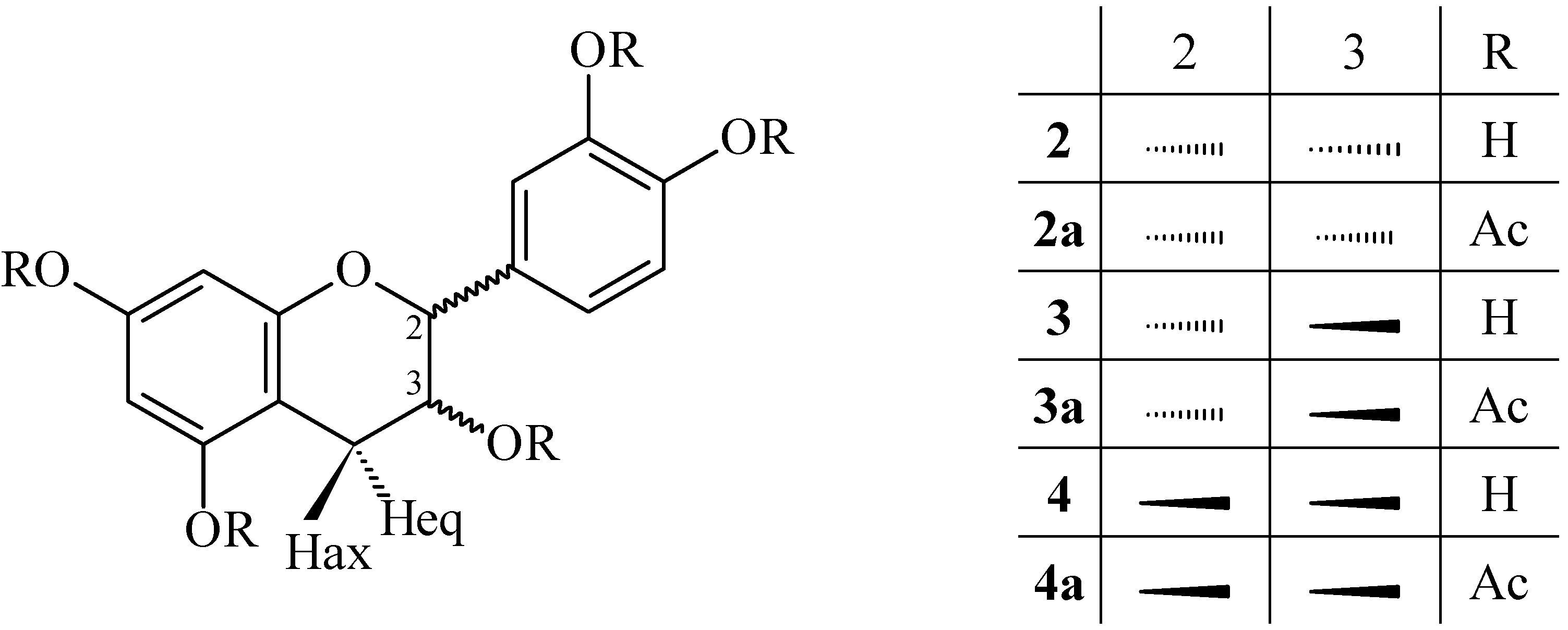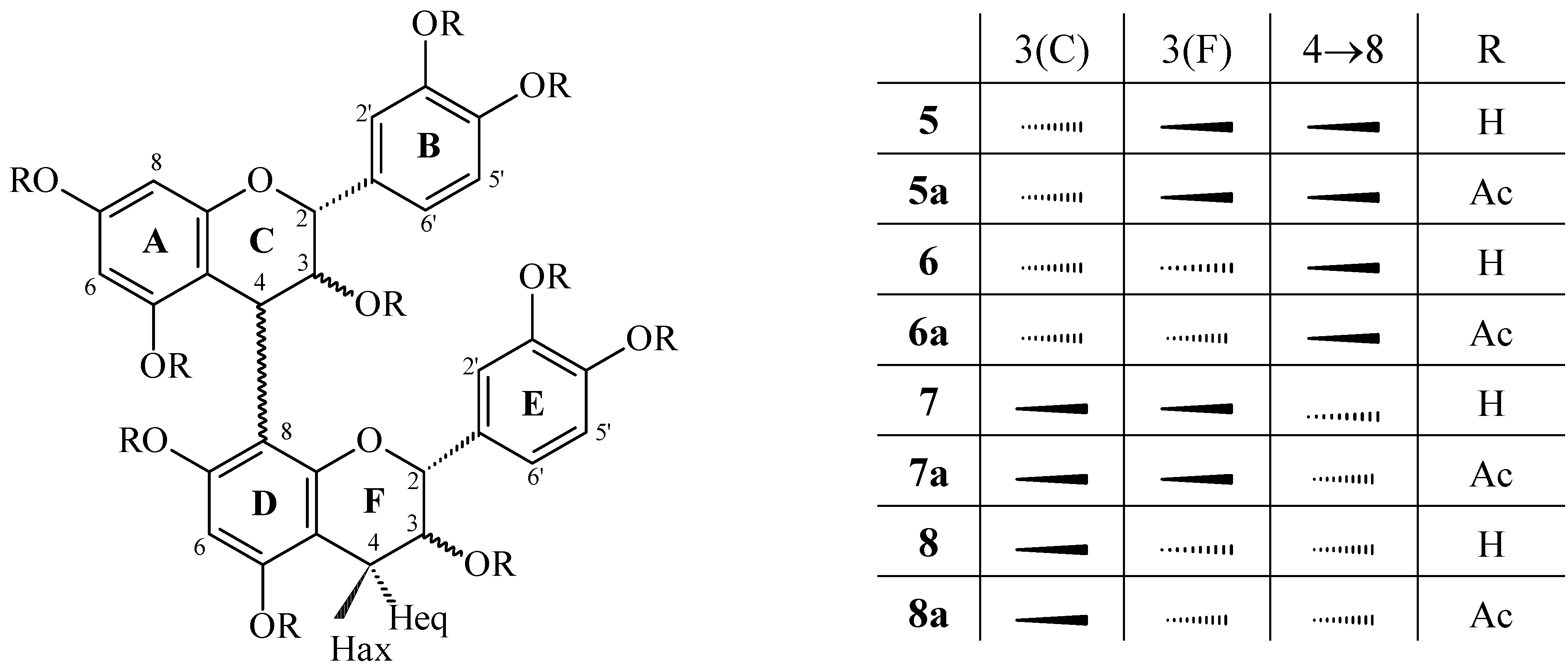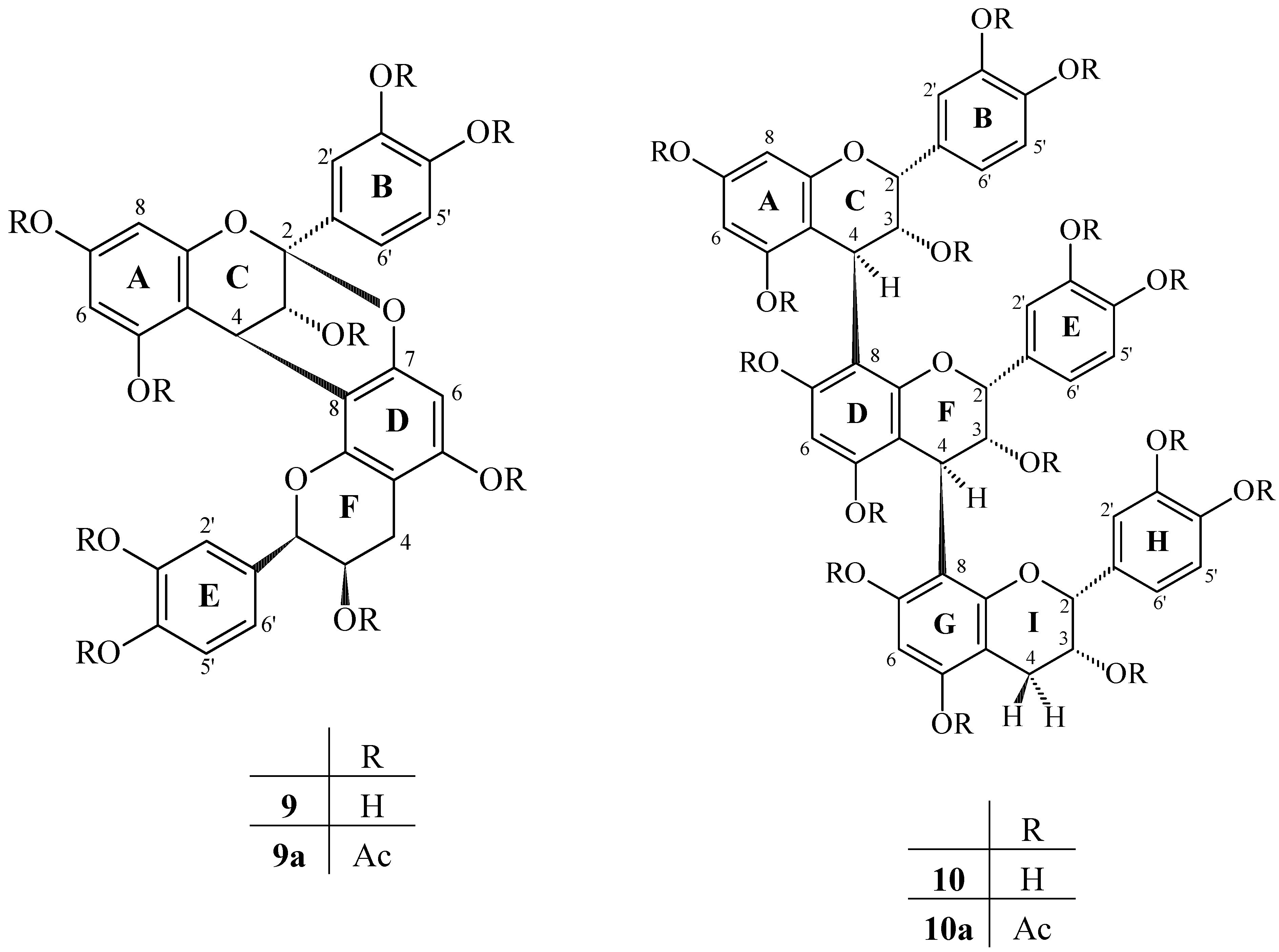Antioxidant Capacity and In Vitro Prevention of Dental Plaque Formation by Extracts and Condensed Tannins of Paullinia cupana
Abstract
:Introduction
Results and Discussion
 ) with authentic material and literature values [11]. Compound 4 (Figure 1) was obtained as a pale yellow, amorphous powder. The 1H-NMR spectrum of acetate 4a showed no difference from compound 3a (epicatechin pentaacetate). The heterocyclic protons displayed an ABMX-system characteristic for the spin pattern of 2,3-cis-flavan-3-ols (J2,3<2.0 Hz) [12,13]. An optical rotation
) with authentic material and literature values [11]. Compound 4 (Figure 1) was obtained as a pale yellow, amorphous powder. The 1H-NMR spectrum of acetate 4a showed no difference from compound 3a (epicatechin pentaacetate). The heterocyclic protons displayed an ABMX-system characteristic for the spin pattern of 2,3-cis-flavan-3-ols (J2,3<2.0 Hz) [12,13]. An optical rotation  of +6° (methanol; c 0.5) verified the 2S,3S absolute configuration of 4a. The ESI mass spectrum showed a prominent peak [M+Na]+at m/z 523.4 and [M-H]- at m/z 499.4, indicating the molecular formula C25H24O11; therefore, 4 was identified as ent-epicatechin. A recent report described the analysis of samples of guaraná by capillary electrophoresis with a natural quiral selector (cyclodextrin), and demonstrated the presence of compounds 2R catechin and epicatechin and their chiral forms 2S (ent-catechin and ent-epicatechin) [14].
of +6° (methanol; c 0.5) verified the 2S,3S absolute configuration of 4a. The ESI mass spectrum showed a prominent peak [M+Na]+at m/z 523.4 and [M-H]- at m/z 499.4, indicating the molecular formula C25H24O11; therefore, 4 was identified as ent-epicatechin. A recent report described the analysis of samples of guaraná by capillary electrophoresis with a natural quiral selector (cyclodextrin), and demonstrated the presence of compounds 2R catechin and epicatechin and their chiral forms 2S (ent-catechin and ent-epicatechin) [14].
 , CD) of their corresponding peracetates 6a, 7a, and 8a with recently published data [11].
, CD) of their corresponding peracetates 6a, 7a, and 8a with recently published data [11]. +2° (methanol; c 1.0), and in combination with the positive Cotton effect in the 220-240 nm region on the CD spectrum of 5a, the identity of 5 (Figure 2) was established as epicatechin-(4β→8)-catechin (procyanidin B1). The proposed structure was supported by ESI mass spectrum data, which showed a prominent [M+Na+]+ peak at m/z 1021.5 and [M-H+]- m/z 997.5.
+2° (methanol; c 1.0), and in combination with the positive Cotton effect in the 220-240 nm region on the CD spectrum of 5a, the identity of 5 (Figure 2) was established as epicatechin-(4β→8)-catechin (procyanidin B1). The proposed structure was supported by ESI mass spectrum data, which showed a prominent [M+Na+]+ peak at m/z 1021.5 and [M-H+]- m/z 997.5.

Biological activity
| Sample | TP (%)±s.d. (RSD%) | RAC±s.d. (RSD%) | IC50 (µg/ml)±s.d. (RSD%) |
|---|---|---|---|
| AqE | 36.47±0.18 (0.51) | 0.46±0.01 (0.96) | 9.59±0.04 (0.41) |
| EBPC | 55.95±1.12 (2.01) | 0.69±0.03 (4.15)* | 6.67±0.05 (0.82) |
| EPA | 65.80±0.62 (0.93) | 0.75±0.01 (1.75)* | 5.23±0.08 (1.49)** |
| EPB | 22.1±0.37 (1.64) | 0.36±0.02 (5.20) | 14.97±0.15 (1.01) |
| Vitamin C | 1.00 | 4.93±0.05 (1.07) |
| Sample | Total Tannins g (%)±sd (RSD%) | Concentration of the sample (mg/ml) | Adherence Inhibition (%) |
|---|---|---|---|
| AqE | 16.16±0.44 (2.75) | 4.64 | 62.18±2.09 |
| EBPC | 31.15±1.46 (4.68) | 2.41 | 79.69±5.23 |
| EPA | 30.05±0.54 (1.80) | 2.50 | 52.69±17.95 |
| EPB | 17.09±0.52 (3.03) | 4.39 | 69.95±2.90 |
| Chlorhexidine | 82.88±4.28 |

Experimental Section
General
 ) were performed in methanol on a Perkin-Elmer 241 spectropolarimeter. Column chromatography (CC; Sephadex℘ LH-20) was carried out using ethanol-water in increasing volumetric proportions. Multi-layer counter-current chromatography (MLCCC): PC ITO Multi-layer Coil Separator-Extractor, Model #1; 800 rpm; eluent system: ethyl acetate-n-propanol-water (140:8:80; v/v); upper layer=mobile phase; flow: 1.0 mL/min. The CC and MLCCC were monitored by TLC (aluminum sheets: silica gel 60 F254; Merck℘; 0.200 mm), under UV254 light and with a solution of 1% FeCl3 in ethanol. DPPH (Fluka) and ammonium molybdate (Merck®) were used as the antioxidant solution.
) were performed in methanol on a Perkin-Elmer 241 spectropolarimeter. Column chromatography (CC; Sephadex℘ LH-20) was carried out using ethanol-water in increasing volumetric proportions. Multi-layer counter-current chromatography (MLCCC): PC ITO Multi-layer Coil Separator-Extractor, Model #1; 800 rpm; eluent system: ethyl acetate-n-propanol-water (140:8:80; v/v); upper layer=mobile phase; flow: 1.0 mL/min. The CC and MLCCC were monitored by TLC (aluminum sheets: silica gel 60 F254; Merck℘; 0.200 mm), under UV254 light and with a solution of 1% FeCl3 in ethanol. DPPH (Fluka) and ammonium molybdate (Merck®) were used as the antioxidant solution.Plant Material
Extraction and isolation of compounds
Total polyphenolics and tannins in EBPC, EPA, EPB, and AqE samples

Relative Antioxidant Capacity (RAC)
Determination of antioxidant capacity by the DPPH• (2,2-diphenyl-1-picrylhydrazyl) method
Cover slip adherence test
Determination of the minimum inhibitory concentration (MIC) by the plate-dilution method
Effect of the extract on the production of acids
 +6° (methanol; c 0.5).
+6° (methanol; c 0.5). +2° (methanol; c 1.0).
+2° (methanol; c 1.0). –4.5° (methanol; c 2.0).
–4.5° (methanol; c 2.0). –31.5° (methanol; c 1.43).
–31.5° (methanol; c 1.43). –16.8° (methanol; c 1.43).
–16.8° (methanol; c 1.43). +5.3° (methanol; c 1.5).
+5.3° (methanol; c 1.5). +5.81° (methanol; c 3.1).
+5.81° (methanol; c 3.1).Acknowledgements
References
- Otobone, F.J.; Sanches, A.C.; Nagae, R.L.; Martins, J.V.C.; Obici, S.; Mello, J.C.P.; Audi, E.A. Effect of Crude Extract and its Semi Purified Constituents from Guaraná Seeds [Paullinia cupana var. sorbilis (Mart.) Ducke on Cognitive Performance in Morris Water Maze in Rats. Braz. Arch. Biol. Technol. 2005, 48, 723–728. [Google Scholar]
- Otobone, F.J.; Sanches, A.C.; Nagae, R.L.; Martins, J.V.C.; Sela, V.L.; Mello, J.C.P.; Audi, E.A. Effect of lyophilized extracts from guaraná seeds [Paullinia cupana var. sorbilis (Mart.) Ducke] on behavorial profiles in rats. Phytother. Res. 2007. [Google Scholar] [CrossRef]
- Antonelli-Ushirobira, T.M.; Yamaguti, E.; Uhemura, L.M.; Mello, J.C.P. Controle de qualidade de amostras de Paullinia cupana H.B.K. var. sorbilis (Mart.) Ducke. Acta Farm. Bonaerense 2004, 23, 383–386. [Google Scholar]
- Ushirobira, T.M.A.; Yamaguti, E.; Uemura, L.M.; Audi, E.A.; Mello, J.C.P. de. Avaliação físico-química de sementes de guaraná secas por diferentes métodos. Rev. Bras. Farmacogn. 2004, 14, 15–20. [Google Scholar] [CrossRef]
- Santos, S.C.; Mello, J.C.P. Farmacognosia: da Planta ao MedicamentoSimões, C.M.O., Schenkel, E.P., Gosmann, G., Mello, J.C.P., Mentz, L.A., Petrovick, P.R., Eds.; UFSC: Florianópolis, 2004, 5th ed.; Chapter 24; pp. 517–544. [Google Scholar]
- Mattei, R.; Dias, R.F.; Espínola, E.B.; Carlini, E.A.; Barros, S.B.M. Guaraná (Paullinia cupana): toxic behavioral effects in laboratory animals and antioxidant activity in vitro. J. Ethnopharmacol. 1998, 60, 111–116. [Google Scholar] [CrossRef]
- Basile, A.; Ferrara, L.; Del Pezzo, M.; Mele, G.; Sorbo, S.; Bassi, P.; Montesano, D. Antibacterial and antioxidant activities of ethanol extract from Paullinia cupana Mart. J. Ethnopharmacol. 2005, 102, 32–36. [Google Scholar] [CrossRef]
- Nakahara, K.; Kawabata, S.; Ono, H.; Ogura, K.; Tanaka, T.; Ooshima, T.; Hamada, S. Inhibitory effect of oolong tea polyphenols on glucosyltransferases of mutans streptococci. Appl. Environ. Microbiol. 1993, 59, 968–973. [Google Scholar]
- Scholz, E. Pflanzliche Gerbstoffe: Pharmakologie und Toxikologie. Deutsch. Apoth. Ztg. 1994, 134, 3167–3179. [Google Scholar]
- Barbosa, G.D.A.F.; Mello, J.C.P. Avaliação clínica do extrato de guaraná no controle da placa bacteriana dentária. Rev. Paulista. Odontol. 2004, 4, 28–30. [Google Scholar]
- Antonelli-Ushirobira, T.M.; Yamaguti, E.; Uemura, L.M.; Nakamura, C.V.; Dias Filho, B.P.; Mello, J.C.P. Chemical and microbiological study of extract from seeds of guaraná (Paullinia cupana var. sorbilis). Lat. Am. J. Pharm. 2007, 26, 5–9. [Google Scholar]
- Weinges, K.; Göritz, K.; Nader, F.; Perner, J. Zur Kenntnis der Proanthocyanidine, XI Konfigurationberstimmung von C30H26O12 – Procyanidine und Strukturaufklärung eines neuen Procyanidins. Liebigs Ann. Chem. 1968, 715, 164–171. [Google Scholar] [CrossRef]
- Weinges, K.; Bähr, W.; Ebert, W.; Göritz, K.; Marx, H.D. Konstitution, Entstehung und Bedeutung der Flavonoid-Gerbstoffe. Fortschr. Chem. Org. Naturst. 1969, 27, 158–260. [Google Scholar]
- Kofink, M.; Galensa, R. Enantiomerentrennung von Catechinen mittels Kapillarelektrophorese. Lebensmittelchem. 2005, 59, 111–112. [Google Scholar]
- Foo, L.Y. Polymeric proanthocyanidins of Photinia glabrescens, modification of molecular weight and nature of products from hydrogenolysis. Phytochemistry 1982, 21, 1741–1746. [Google Scholar] [CrossRef]
- Romeyer, F.M.; Macheix, J.J.; Sapis, J.C. Changes and importance of oligomeric procyanidins during maturation of grape seeds. Phytochemistry 1985, 25, 219–221. [Google Scholar] [CrossRef]
- Lu, Y.; Foo, L.Y. The polyphenol constituents of grape pomace. Food Chem. 1999, 65, 1–8. [Google Scholar] [CrossRef]
- Khallouki, F.; Haubner, R.; Hull, W.E.; Erben, G.; Spiegelhalder, B.; Bartsch, H.; Owen, R.W. Isolation, purification and identification of ellagic acid derivatives, catechins, and procyanidins from the root bark of Anisophyllea dichostyla R. Br. Food Chem. Toxicol. 2007, 45, 472–485. [Google Scholar] [CrossRef]
- Petereit, F.; Kolodziej, H.; Nahrstedt, A. Flavan-3-ols and proanthocyanidins from Cistus incanus. Phytochemistry 1991, 30, 981–985. [Google Scholar] [CrossRef]
- Hemingway, R.W.; Foo, L.Y.; Porter, L.J. Linkage isomerism in trimeric and polymeric 2,3-cis-procyanidins. J. Chem. Soc., Perkin Trans. 1 1982, 1209–1216. [Google Scholar] [CrossRef]
- Kolodziej, H. Tannins of medicinal plants: application of 1H NMR parameters to the analysis of procyanidins. Farmaceut. Tijdschr. Belg. 1989, 66e, 44. [Google Scholar]
- Mello, J.P.; Petereit, F.; Nahrstedt, A. Flavan-3-ols and prodelphinidins from Stryphnodendron adstringens. Phytochemistry 1996, 41, 807–813. [Google Scholar] [CrossRef]
- Kolodziej, H. Plant Polyphenols: Synthesis, Properties, Significance; Hemingway, R.W., Laks, P.E., Eds.; Plenum Press: New York, 1992; pp. 295–320. [Google Scholar]
- Hör, M.; Rimpler, H.; Heinrich, M. Inibition of intestinal chloride secretion by proanthocyanidins from Guazuma ulmifolia. Planta Med. 1995, 61, 208–212. [Google Scholar] [CrossRef]
- Jacques, D.; Haslam, E.; Bedford, G.R.; Greatbanks, D. Plant proanthocyanidins. Part II. Proanthocyanidin-A2 and its derivatives. J. Chem. Soc., Perkin Trans. 1 1974, 2663–2671. [Google Scholar]
- Foo, L.Y.; Lu, Y.; Howell, A.B.; Vorsa, N. The structure of cranberry proanthocyanidins which inhibit adherence of uropathogenic P-fimbriated Escherichia coli in vitro. Phytochemistry 2000, 54, 173–181. [Google Scholar] [CrossRef]
- Ueffing, I. Untersuchung von Procyanidinen in Tilia spec.-ein Beitrag zur qualitativen und quantitativen HPLC-Analytik von Flavanolen. PhD. Thesis, Münster, Germany, 1988. [Google Scholar]
- Resende, F.O. Trichilia catigua: Avaliação farmacognóstica, fitoquímica e biológica in vitro. M.Sc. Thesis, Maringá, Brazil, 2007; p. 164p. [Google Scholar]
- National Committee For Clinical Laboratory Standards. Methods for dilution antimicrobial susceptibility tests for bacteria that grow aerobically; NCCLS Approved Standard M7-A5; Wayne, PA; 2000; Vol. 20, n. 2. [Google Scholar]
- Andrade, L.; Schenkel, E.P.; Bergold, A.M. Estudo da metodologia de análise de cafeína em sementes de guaraná (Paullinia cupana). Rev. Bras. Farmacogn. 1999, 80, 7–9. [Google Scholar]
- Patent No. PI 0006638-9. Efeito antidepressivo do extrato da droga vegetal guaraná (Paullinia cupana var. sorbilis (Martius) Ducke). Brazil. Available online: http://www.inpi.gov.br. Accessed at 31 july 2007.
- Glasl, H. Zur Photometrie in der Drogenstandardisierung. 3. Gehaltsbestimmung von Gerbstoffdrogen. Deutsch. Apoth. Ztg. 1983, 123, 1979–1983. [Google Scholar]
- Prieto, P.; Pineda, M.; Aguilar, M. Spectrophotometric quantitation of antioxidant capacity through the formation of a phosphomolybdenum complex: specific application to the determination of vitamin E. Anal. Biochem. 1999, 269, 337–341. [Google Scholar] [CrossRef]
- Amarowicz, R.; Pegg, R.B.; Rahimi-Moghaddam, P.; Barl, B.; Weil, J.A. Free-radical scavenging capacity and antioxidant activity of selected plant species from the Canadian prairies. Food Chem. 2004, 84, 551–562. [Google Scholar] [CrossRef]
- Hamada, S.; Torii, M.; Kotani, S.; Tsuchitani, Y. Adherence of Streptococcus sanguis clinical isolates to smooth surfaces and interaction of the isolates with Streptococcus mutans glucosyltransferase. Infect. Immun. 1981, 32, 364–372. [Google Scholar]
- Ooshima, T.; Osaka, Y.; Sasaki, H.; Osawa, K.; Yasuda, H.; Matsumura, M.; Sobue, S.; Matsumoto, M. Caries inhibitory activity of cacao bean husk extract in in-vitro and animal experiments. Arch. Oral Biol. 2000, 45, 639–645. [Google Scholar] [CrossRef]
- Sample Availability: Available from the authors.
© 2006 by MDPI (http://www.mdpi.org). Reproduction is permitted for noncommercial purposes.
Share and Cite
Yamaguti-Sasaki, E.; Ito, L.A.; Canteli, V.C.D.; Ushirobira, T.M.A.; Ueda-Nakamura, T.; Filho, B.P.D.; Nakamura, C.V.; Palazzo de Mello, J.C. Antioxidant Capacity and In Vitro Prevention of Dental Plaque Formation by Extracts and Condensed Tannins of Paullinia cupana. Molecules 2007, 12, 1950-1963. https://doi.org/10.3390/12081950
Yamaguti-Sasaki E, Ito LA, Canteli VCD, Ushirobira TMA, Ueda-Nakamura T, Filho BPD, Nakamura CV, Palazzo de Mello JC. Antioxidant Capacity and In Vitro Prevention of Dental Plaque Formation by Extracts and Condensed Tannins of Paullinia cupana. Molecules. 2007; 12(8):1950-1963. https://doi.org/10.3390/12081950
Chicago/Turabian StyleYamaguti-Sasaki, Elza, Lia Akina Ito, Vanessa Cristina Dias Canteli, Tânia Mara Antonelli Ushirobira, Tânia Ueda-Nakamura, Benedito Prado Dias Filho, Celso Vataru Nakamura, and João Carlos Palazzo de Mello. 2007. "Antioxidant Capacity and In Vitro Prevention of Dental Plaque Formation by Extracts and Condensed Tannins of Paullinia cupana" Molecules 12, no. 8: 1950-1963. https://doi.org/10.3390/12081950




